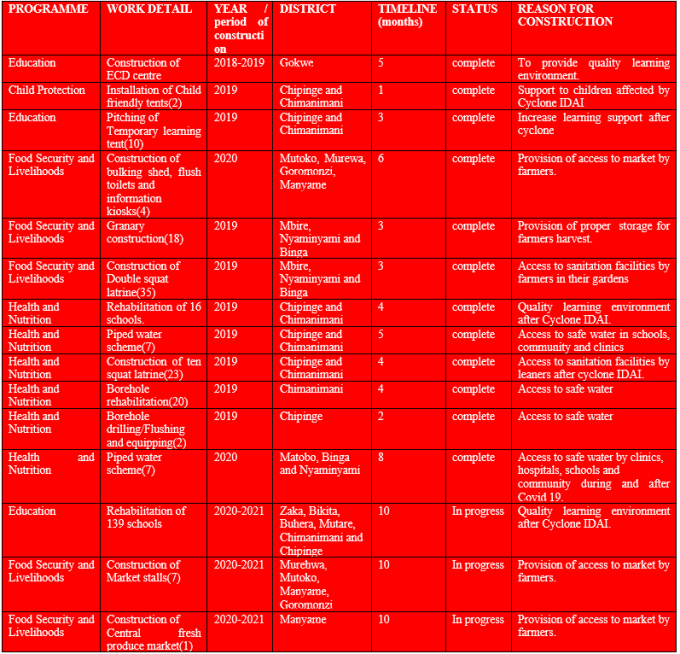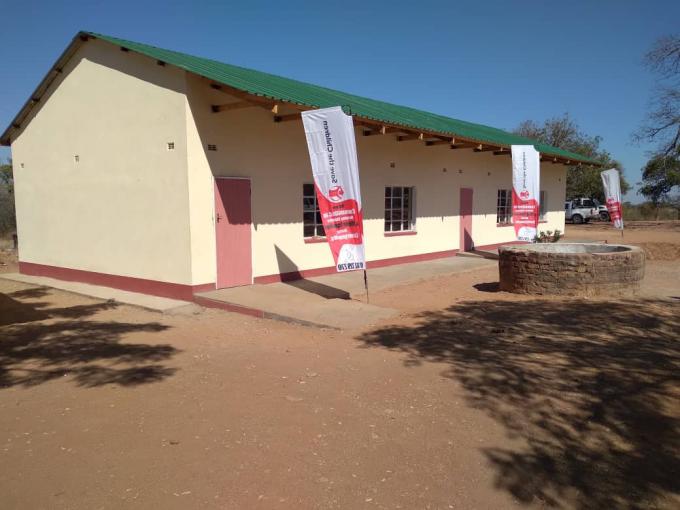Q & A: SC Zim Construction Engineer talks “All things construction”
Save the Children has worked on a number of construction projects in its districts of operation from 2019 to date. These include construction of market stalls, piped water schemes, and rehabilitation of schools among others. Save the Children Engineer, Edmore Mugiyo explains more on construction works in Zimbabwe:
Q: What role do you play in Save the Children Zimbabwe’s construction projects?
A: My role is to provide overall technical management and support to the country programmes and local partners in planning and undertaking construction and WASH project activities. I also provide guidance to other programme managers on designing, planning, scheduling and supervisory requirements of various infrastructure and construction projects such as site assessments, preparation of Bills of Quantities, hiring of contractors, monitoring construction and final inspection of infrastructure work.
Q: How big is your team of engineers under Save the Children Zimbabwe office?
A: I don’t have a big team. We are only two, that is the Assistant Engineer and myself.
Q: Apart from Save the Children Zimbabwe staff, who else do you work with?
A: We work with the Global Construction Lead and Regional Construction Advisor. They offer overall guidance on all construction projects and ensuring works are done as per the SCI construction policy and Standard Operational Procedures for Zimbabwe. We also work with Engineers, Architects, Planners and Technicians for the Rural District councils, Ministry of Public Works, Ministry of Health and Child Care, District Development Fund and Ministry of Primary and Secondary Education. These technocrats from the government are there to ensure all designs and construction meet their standards, and specifications are followed during the construction process until handover of the completed structures.
Q: What construction projects has Save the Children in Zimbabwe been working on from 2019 to now?
A: We have done a lot of construction projects since 2019 ranging from, ECD centres, Child friendly space, temporary learning spaces, bulking sheds, Information kiosks flush toilets, Blair ventilated Improved Pit Latrine, granaries, rehabilitation of 139 schools, rehabilitation of boreholes construction of piped water schemes, market stalls and central fresh produce as shown on the table below.

Q: Can you say you achieved your targets on time?
A: Yes. As new projects come, we also set new targets and work towards achieving these.
Q: What are some of the steps you have employed to enhance safety on site?
A: When we talk safety at a construction site, we are not only focusing on the safety of construction workers. We are also concerned about the safety of other people who come to our site or those who reside or spend time in the area where we are working in. Besides safety from any physical harm that may be caused by construction tools and materials like nails, we also now have to ensure our site is safe with respect to COVID-19. Most of our construction works are taking place in schools, people’s markets and in communities, where there are children, and they require protection as well. We have therefore taken a number of steps to ensure that our sites are safe for children, community members as well as the construction workers. I am pleased to say that we trained all construction staff on child safeguarding and site safety including sharing tools that were used during construction. We conduct this mandatory training prior to the beginning on any construction works. All our sites have hoarding, hazard or danger tape and site staff are required to wear complete Personal Protective Equipment (PPE). Another step that we employ is to ensure no children are allowed near construction sites. At all the schools we worked in, we started by training learners on dangers of entering construction sites, and we distributed posters with danger warning signs.
Q: Did the COVID-19 pandemic affect the ongoing construction projects?
A: Construction was affected during the first month of lockdown, March 2020, but thereafter our operations were declared essential therefore the works had to resume.
Q: What practises have you put in place to ensure continuity of works in the COVID-19 context?
A: All contractors and stakeholders were trained on COVID-19 new site operational guidelines. This was strictly adhered to as there were no cases of COVD-19 reported from our construction sites.
Q: How have you adjusted your construction works to suit the COVID-19 protocols like the restrictions on movement and lockdowns?
A: From the time our construction works were classified as essential services, all our project contractors and their workers were given letters to enable them to freely travel to and from different sites. So we were able to continue with our work.
Q: How have you been applying the Construction Policy at all the construction sites?
A: We have been applying construction policy by ensuring essential programming for the improvement of outcomes for children in construction projects were met and accepted local (government) or internationally accepted standards for structural life safety, public health as well as WASH are put into practice. We also considered locally assessed multiple hazards; incorporate hazard mitigation techniques whilst engaging partners throughout the process and ensuring that community buy‐in as well as ownership of the building in operation.
Q: Are there any construction benchmark standards that you are using to ensure quality?
A:Yes, we used all SCI benchmark standards depending on the nature of the construction project as they will increase the quality outcomes that mitigate risks and realise opportunities for children and their communities.
Q: To what extent has the economic challenges as well as power crisis affected your works?
A: The economic policy changed several times during the construction phases and this increased the price of materials thereby redesigning some structures to fit the budget. The power cuts also increase the project duration as more time was required to do fabrication of steel members.
Q: Are communities you work in involved in the construction works? If yes, how are they involved?
A: The communities provide locally available materials needed for construction and casual labour for the construction project. Some artisans are recruited by the contractor during construction as well as by Save the Children when we are doing direct implementation.
Q: How will the communities benefit from the construction works?
A: Construction projects create employment for the community. The community members are the beneficiaries of the infrastructure as well. For example, through construction of the piped water scheme, community members will have access to safe water. The market stalls we are constructing will enable community members to have access to a market place. Children now learn in safe and secure spaces after we rehabilitated of 139 schools which were damaged by Cyclone Idai.

Q: Do you receive any feedback from communities regarding the work you are doing?
A: Yes, especially for the bulking sheds we constructed. The vendors are happy as they now sell their produce at safe spaces which protect them from the sun and rains. I have also been told by some community members that they are no longer exposed to diarrheal diseases as they now have access to clean water and they now water vegetable gardens using water from the piped water scheme. Teachers whose houses were rehabilitated after being damaged by Cyclone Idai say they now want to stay at the schools and stop commuting daily to and from their homes. That’s positive feedback!
Q: What advice do you have for other Save the Children offices working on construction projects?
A: I encourage them to fully utilise our SCI Construction policy as well as Country Office Standard Operating procedures (SOPs). They should also ensure construction works are done by qualified engineers.
 Zimbabwe
Zimbabwe